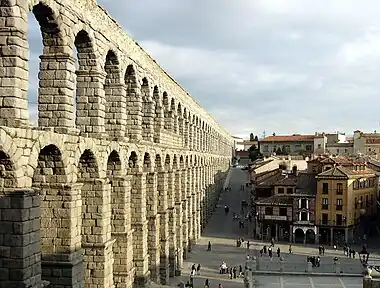Aqua Crabra was a Roman aqueduct supplying villas in the hinterland of the ancient town of Tusculum.
The Aqua Crabra is described by Cicero in his treatise De Lege Agraria ("On the Agrarian Law") where we learn it supplied his villa near Tusculum.[1][2]
The aqueduct is also attested in the text of Frontinus.[3][4] The Crabra is sometimes referred to as Aqua Mariana or Aqua Maranna del Maria.[5]
The evidence offered by CIL VI, 1261 was interpreted by Mommsen to be connected with the Aqua Crabra, even though there is no specific mention of it in the fragmentary text.[6]
Archaeological discoveries announced in December 2014 in conjunction with Rome's Metro C excavations have been preliminarily linked with the Aqua Crabra. This discovery consists of a large hydraulic reservoir, perhaps the largest known from the ancient city, along with a water wheel and agricultural implements.[7][8]
See also
References
- ↑ Cic. De Lege Agraria 3.9.7 http://latin.packhum.org/loc/474/11/25/3151-3162
- ↑ Annalisa Marzano (2007). Roman Villas in Central Italy: A Social and Economic History. BRILL. pp. 167–. ISBN 90-04-16037-X.
- ↑ Frontin. 9.4.1 http://latin.packhum.org/loc/1245/2/0#0
- ↑ Harry B. Evans (1997). Water Distribution in Ancient Rome: The Evidence of Frontinus. University of Michigan Press. pp. 61–. ISBN 0-472-08446-1.
- ↑ Strother Ancrum Smith (1877). The Tiber and Its Tributaries: Their Natural History and Classical Associations. Longmans, Green, and Company. pp. 21–.
- ↑ Cynthia Bannon (1 January 2009). Gardens and Neighbors: Private Water Rights in Roman Italy. University of Michigan Press. pp. 80–. ISBN 0-472-02564-3.
- ↑ "Down on the farm: Dig for Rome subway finds ancient ag business with pitchfork, waterwheel" U.S. News & World Report 3 December 2014 https://www.usnews.com/news/world/articles/2014/12/03/work-on-rome-subway-digs-up-ancient-farm-tools
- ↑ "Largest ancient Roman water basin uncovered Massive structure dates back to 3rd century BC" ANSA 3 December 2014 http://www.ansa.it/english/news/2014/12/03/largest-ancient-roman-water-basin-uncovered_45e03972-aedf-4899-8c3e-ea6b21a180fb.html

